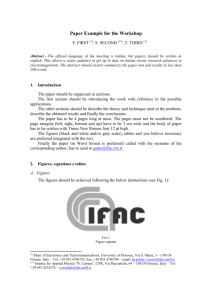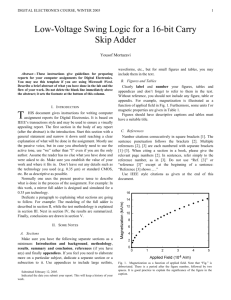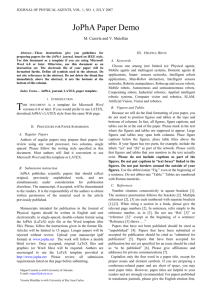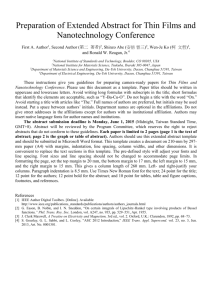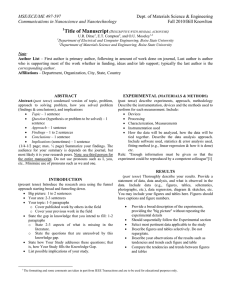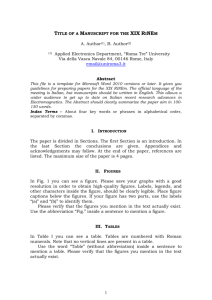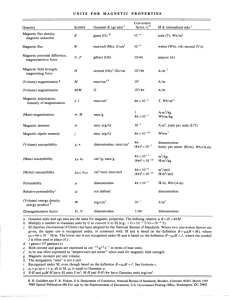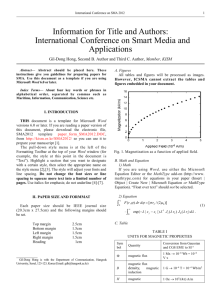II. Paper Submission
advertisement
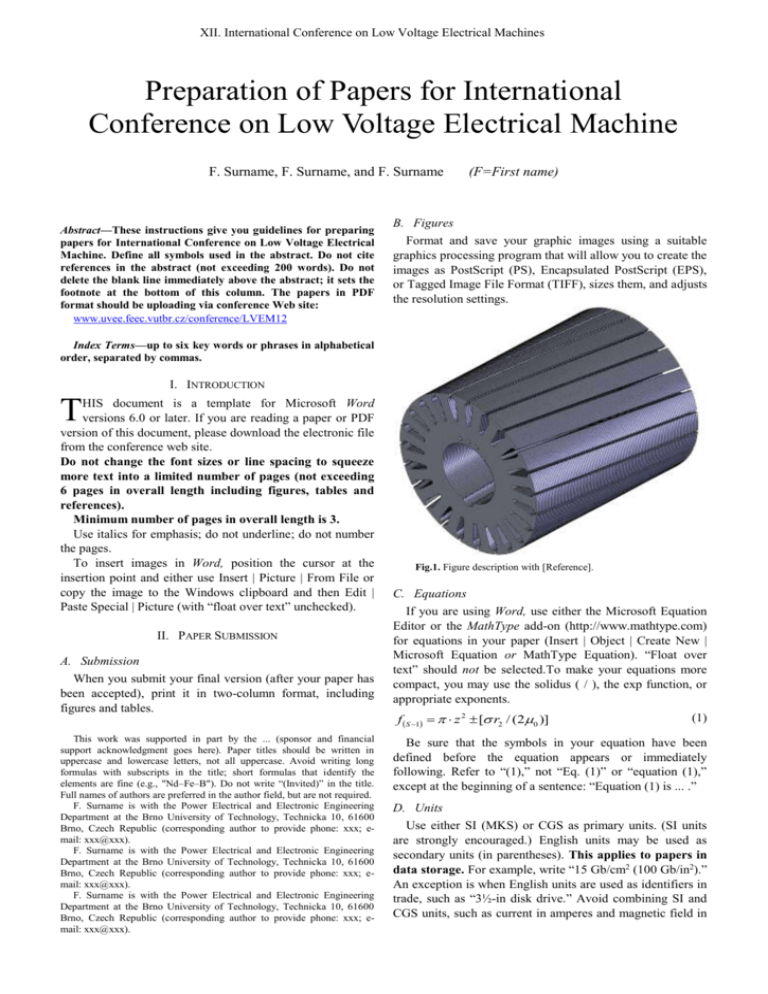
XII. International Conference on Low Voltage Electrical Machines Preparation of Papers for International Conference on Low Voltage Electrical Machine F. Surname, F. Surname, and F. Surname Abstract—These instructions give you guidelines for preparing papers for International Conference on Low Voltage Electrical Machine. Define all symbols used in the abstract. Do not cite references in the abstract (not exceeding 200 words). Do not delete the blank line immediately above the abstract; it sets the footnote at the bottom of this column. The papers in PDF format should be uploading via conference Web site: www.uvee.feec.vutbr.cz/conference/LVEM12 (F=First name) B. Figures Format and save your graphic images using a suitable graphics processing program that will allow you to create the images as PostScript (PS), Encapsulated PostScript (EPS), or Tagged Image File Format (TIFF), sizes them, and adjusts the resolution settings. Index Terms—up to six key words or phrases in alphabetical order, separated by commas. I. INTRODUCTION T HIS document is a template for Microsoft Word versions 6.0 or later. If you are reading a paper or PDF version of this document, please download the electronic file from the conference web site. Do not change the font sizes or line spacing to squeeze more text into a limited number of pages (not exceeding 6 pages in overall length including figures, tables and references). Minimum number of pages in overall length is 3. Use italics for emphasis; do not underline; do not number the pages. To insert images in Word, position the cursor at the insertion point and either use Insert | Picture | From File or copy the image to the Windows clipboard and then Edit | Paste Special | Picture (with “float over text” unchecked). II. PAPER SUBMISSION A. Submission When you submit your final version (after your paper has been accepted), print it in two-column format, including figures and tables. This work was supported in part by the ... (sponsor and financial support acknowledgment goes here). Paper titles should be written in uppercase and lowercase letters, not all uppercase. Avoid writing long formulas with subscripts in the title; short formulas that identify the elements are fine (e.g., "Nd–Fe–B"). Do not write “(Invited)” in the title. Full names of authors are preferred in the author field, but are not required. F. Surname is with the Power Electrical and Electronic Engineering Department at the Brno University of Technology, Technicka 10, 61600 Brno, Czech Republic (corresponding author to provide phone: xxx; email: xxx@xxx). F. Surname is with the Power Electrical and Electronic Engineering Department at the Brno University of Technology, Technicka 10, 61600 Brno, Czech Republic (corresponding author to provide phone: xxx; email: xxx@xxx). F. Surname is with the Power Electrical and Electronic Engineering Department at the Brno University of Technology, Technicka 10, 61600 Brno, Czech Republic (corresponding author to provide phone: xxx; email: xxx@xxx). Fig.1. Figure description with [Reference]. C. Equations If you are using Word, use either the Microsoft Equation Editor or the MathType add-on (http://www.mathtype.com) for equations in your paper (Insert | Object | Create New | Microsoft Equation or MathType Equation). “Float over text” should not be selected.To make your equations more compact, you may use the solidus ( / ), the exp function, or appropriate exponents. f S 1 z 2 [ r2 / (20 )] (1) Be sure that the symbols in your equation have been defined before the equation appears or immediately following. Refer to “(1),” not “Eq. (1)” or “equation (1),” except at the beginning of a sentence: “Equation (1) is ... .” D. Units Use either SI (MKS) or CGS as primary units. (SI units are strongly encouraged.) English units may be used as secondary units (in parentheses). This applies to papers in data storage. For example, write “15 Gb/cm2 (100 Gb/in2).” An exception is when English units are used as identifiers in trade, such as “3½-in disk drive.” Avoid combining SI and CGS units, such as current in amperes and magnetic field in XII. International Conference on Low Voltage Electrical Machines oersteds. This often leads to confusion because equations do not balance dimensionally. If you must use mixed units, clearly state the units for each quantity in an equation. The SI unit for magnetic field strength H is A/m. However, if you wish to use units of T, either refer to magnetic flux density B or magnetic field strength symbolized as µ0H. Use the center dot to separate compound units, e.g., “A·m2.” TABLE I UNITS FOR MAGNETIC PROPERTIES Symbol B Quantity H m magnetic flux magnetic flux density, magnetic induction magnetic field strength magnetic moment M magnetization 4M j J magnetization specific magnetization magnetic dipole moment magnetic polarization , susceptibility mass susceptibility permeability r w, W N, D relative permeability energy density demagnetizing factor Conversion from Gaussian and CGS EMU to SI a 1 Mx 108 Wb = 108 V·s 1 G 104 T = 104 Wb/m2 1 Oe 103/(4) A/m 1 erg/G = 1 emu 103 A·m2 = 103 J/T 1 erg/(G·cm3) = 1 emu/cm3 103 A/m 1 G 103/(4) A/m 1 erg/(G·g) = 1 emu/g 1 A·m2/kg 1 erg/G = 1 emu 4 1010 Wb·m 1 erg/(G·cm3) = 1 emu/cm3 4 104 T 1 4 1 cm3/g 4 103 m3/kg 1 4 107 H/m = 4 107 Wb/(A·m) r 1 erg/cm3 101 J/m3 1 1/(4) Vertical lines are optional in tables. Statements that serve as captions for the entire table do not need footnote letters. aGaussian units are the same as cgs emu for magnetostatics; Mx = maxwell, G = gauss, Oe = oersted; Wb = weber, V = volt, s = second, T = tesla, m = meter, A = ampere, J = joule, kg = kilogram, H = henry. III. RECOMMENDATIONS A. References Number citations consecutively in square brackets [1]. The sentence punctuation follows the brackets [2]. Multiple references [2], [3] are each numbered with separate brackets [1]–[3]. When citing a section in a book, please give the relevant page numbers [2]. In sentences, refer simply to the reference number, as in [3]. Do not use “Ref. [3]” or “reference [3]” except at the beginning of a sentence: “Reference [3] shows ... .” Please do not use automatic endnotes in Word, rather, type the reference list at the end of the paper using the “References” style. Please note that the references at the end of this document are in the preferred referencing style. Give all authors’ names; do not use “et al.” unless there are six authors or more. Use a space after authors’ initials. Capitalize only the first word in a paper title, except for proper nouns and element symbols. IV. EDITORIAL POLICY Submission of a manuscript is not required for participation in a conference. Do not submit a reworked version of a paper you have submitted or published elsewhere. Do not publish “preliminary” data or results. The submitting author is responsible for obtaining agreement of all coauthors and any consent required from sponsors before submitting a paper. LVEM editors strongly discourage courtesy authorship. It is the obligation of the authors to cite relevant prior work. V. CONCLUSION A conclusion section is not required. Although a conclusion may review the main points of the paper, do not replicate the abstract as the conclusion. A conclusion might elaborate on the importance of the work or suggest applications and extensions. If you are writing your text directly to this document do not forget to remove all comments! APPENDIX Appendixes, if acknowledgment. needed, appear before the ACKNOWLEDGMENT Sponsor and financial support acknowledgments are placed in the unnumbered footnote on the first page, not here. REFERENCES [1] [1] [2] [3] G. O. Young, “Synthetic structure of industrial plastics (Book style with paper title and editor),” in Plastics, 2nd ed. vol. 3, J. Peters, Ed. New York: McGraw-Hill, 1964, pp. 15–64. Gun Hee Jang; Park, S.J.; , "Characterization of a single-phase induction motor due to the effect of slot opening," Magnetics, IEEE Transactions on, vol.40, no.4, pp. 2065- 2067, July 2004. doi: 10.1109/TMAG. 2004.829163. Gerling, D.; , "Influence of the stator slot opening on the characteristics of windings with concentrated coils," Electric Machines and Drives Conference, 2009. IEMDC '09. IEEE International , vol., no., pp.1710-1714, 3-6 May 2009. doi: 10.1109/IEMDC.2009.5075433. Jelassi, S.; Romary, R.; Brudny, J.F.; , "Slot design for dynamic iron loss AC rotating electrical machine reduction," Energy Conversion Congress and Exposition (ECCE), 2010 IEEE , vol., no., pp.563-569, 12-16 Sept. 2010. doi: 10.1109/ECCE.2010.5617966. THE AUTHOR(S) First A. Author (M’76–SM’81–F’87) and the other authors may include biographies at the end of regular papers. Biographies are often not included in conference-related papers. This author became a Member (M) of IEEE in 1976, a Senior Member (SM) in 1981, and a Fellow (F) in 1987. The first paragraph may contain a place and/or date of birth (list place, then date). Next, the author’s educational background is listed. The degrees should be listed with type of degree in what field, which institution, city, state, and country, and year degree was earned. The author’s major field of study should be lower-cased. It lists military and work experience, including summer and fellowship jobs. Job titles are capitalized. The current job must have a location; previous positions may be listed without one. Current and previous research interests end the paragraph. Personal hobbies will be deleted from the biography.
